Content for TS 29.502 Word version: 18.7.0
1…
5…
5.2.2…
5.2.2.2.4…
5.2.2.3…
5.2.2.3.2…
5.2.2.3.3…
5.2.2.3.6…
5.2.2.3.8…
5.2.2.3.10…
5.2.2.3.17…
5.2.2.3.23…
5.2.2.4…
5.2.2.8…
5.2.2.8.2…
5.2.2.8.2.7…
5.2.2.8.2.12…
5.2.2.8.2.20…
5.2.2.8.3…
5.2.2.8.3.6…
5.2.2.9…
5.2.3…
6…
6.1.2…
6.1.3…
6.1.3.3…
6.1.3.5…
6.1.3.6…
6.1.3.7…
6.1.4…
6.1.6…
6.1.6.2…
6.1.6.2.5…
6.1.6.2.11…
6.1.6.2.18…
6.1.6.2.27…
6.1.6.2.40…
6.1.6.2.54…
6.1.6.2.65…
6.1.6.3…
6.1.6.4…
6.1.7…
A…
B…
C…
5.2.2.3.10 P-CSCF Restoration Procedure via AMF
5.2.2.3.11 AMF requested PDU Session Release due to duplicated PDU Session Id
5.2.2.3.12 AMF requested PDU Session Release due to slice not available
5.2.2.3.13 Indirect Data Forwarding Tunnel establishment during N2 based Handover with I-SMF
5.2.2.3.13A Indirect Data Forwarding Tunnel removal during N2 based Handover with I-SMF
5.2.2.3.14 Request to forward buffered downlink data packets at I-UPF
5.2.2.3.15 Connection Suspend procedure
5.2.2.3.16 Connection Resume in CM-IDLE with Suspend procedure
...
...
5.2.2.3.10 P-CSCF Restoration Procedure via AMF p. 46
The requirements specified in clause 5.2.2.3.1 shall apply with the following modifications.
Step 1.
Same as step 1 of Figure 5.2.2.3.1-1, with the following modifications.
The POST request shall contain:
- the release IE set to true;
- the cause IE set to REL_DUE_TO_REACTIVATION.
5.2.2.3.11 AMF requested PDU Session Release due to duplicated PDU Session Id p. 46
When the AMF receives an "initial request" with PDU Session Id which already exists in PDU session context of the UE (see clause 5.4.5.2.5 of TS 24.501), the AMF shall request the SMF to release the existing PDU Session; upon subsequent receipt of an SM context status notification indicating that the SM context has been deleted in the SMF, the AMF shall release the stored context for the PDU session and proceed with the "initial request" with the PDU Session Id.
The requirements for releasing the existing PDU Session specified in clause 5.2.2.3.1 shall apply with the following modifications.
Step 1.
When the SMF receives the request from AMF, the SMF shall start the PDU Session Release procedure to release all the associated resources in UPF, PCF, CHF, and UDM. If the UP connection of the existing PDU session is active, the SMF should also request (R)AN to release associated resources.
Same as step 1 of Figure 5.2.2.3.1-1, with the following modifications.
The POST request shall contain:
- the release IE set to true;
- the cause IE set to REL_DUE_TO_DUPLICATE_SESSION_ID.
5.2.2.3.12 AMF requested PDU Session Release due to slice not available p. 46
If a network slice is detected as not available (e.g. due to slice congestion or operational disable the slice), the NF Service Consumer (i.e. AMF) shall use this procedure to release the PDU session associated to the unavailable network slice. Such handling of PDU session release may also happen in network slice replacement procedure if the AMF determines the PDU session cannot be retained with the alternative S-NSSAI due to certain reason (e.g. V-SMF/I-SMF cannot support the alternative S-NSSAI) (see clause 4.3.3.3 of TS 23.502).
The requirements specified in clause 5.2.2.3.1 shall apply with the following modifications.
Step 1.
Same as step 1 of Figure 5.2.2.3.1-1, with the following modifications.
The POST request shall contain:
- the release IE set to true;
- the cause IE set to S_NSSAI_CONGESTION or REL_DUE_TO_SLICE_NOT_AVAILABLE;
- optionally the skipN2PduSessionResRelInd IE with the value "true" to skip RAN resources release for the PDU session, e.g. for a PDU session with active UP associated with a slice that is no longer available after a handover.
5.2.2.3.13 Indirect Data Forwarding Tunnel establishment during N2 based Handover with I-SMF |R16| p. 47
During N2 based handover with I-SMF insertion/change/removal, the NF Service Consumer (e.g. target I-SMF) shall use this procedure to exchange N3/N9 forwarding tunnel information with the NF Service Producer (e.g. source I-SMF).
The NF Service Consumer (e.g. target I-SMF) shall request the SMF to establish one or more downlink and/or uplink indirect data forwarding tunnels, as follows.
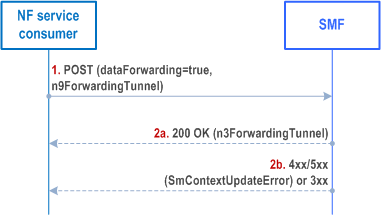
Step 1.
The NF Service Consumer shall send a POST request, as specified in clause 5.2.2.3.1, with the following information:
Step 2a.
- dataForwarding attribute set to true, for the N2 based handover with I-SMF insertion/change/removal;
- n9DlForwardingTnlList attribute carrying the N9 downlink indirect data forwarding tunnel(s) info of target I-UPF;
- n9UlForwardingTnlList attribute carrying the N9 uplink indirect data forwarding tunnel(s) info of target I-UPF;
- other information, if necessary.
Same as step 2a of Figure 5.2.2.3.1-1, with the following information:
Step 2b.
- n3DlForwardingTnlList attribute carrying the N3 downlink indirect data forwarding tunnel(s) info of source I-UPF or source UPF;
- n3UlForwardingTnlList attribute carrying the N3 uplink indirect data forwarding tunnel(s) info of source I-UPF or source UPF;
- other information, if necessary.
If the source SMF cannot proceed with the request, the source I-SMF shall return an error response, as specified for step 2b of Figure 5.2.2.3.1-1.
5.2.2.3.13A Indirect Data Forwarding Tunnel removal during N2 based Handover with I-SMF |R16| p. 47
During N2 based handover cancellation with I-SMF insertion/change/removal, the NF Service Consumer (e.g. target I-SMF) shall use this procedure to remove previously established Indirect Data Forwarding Tunnel(s) at NF Service Producer (e.g. source I-SMF).
The NF Service Consumer (e.g. target I-SMF) shall request the NF service producer to remove the established Indirect Data Forwarding Tunnel(s), as follows.
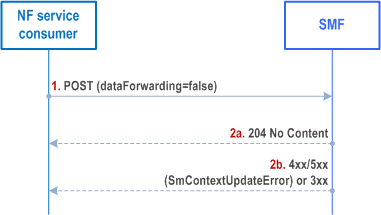
Step 1.
The NF Service Consumer shall send a POST request, as specified in clause 5.2.2.3.1, with the following information:
Step 2a.
- dataForwarding attribute set to false;
- other information, if necessary.
If successful, the SMF shall return a 204 No Content response.
Step 2b.
If the SMF cannot proceed with the request, the SMF shall return an error response, as specified for step 2b of Figure 5.2.2.3.1-1.
5.2.2.3.14 Request to forward buffered downlink data packets at I-UPF |R16| p. 48
For I-SMF change or I-SMF removal when downlink data packets are buffered at the I-UPF, the new I-SMF (for I-SMF change) or SMF (for I-SMF removal) shall request the (old) I-SMF to forward buffered downlink data packets as following:
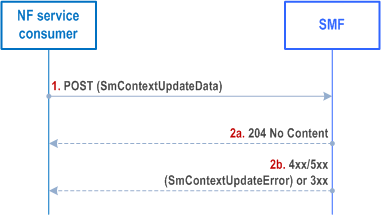
Step 1.
The NF Service Consumer shall send a POST request, as specified in clause 5.2.2.3.1, with the following information:
Step 2a.
- n9ForwardingTunnel IE indicating the allocated tunnel endpoints information to receive the buffered downlink data packets.
On success, the SMF shall initiate N4 session modification to the I-UPF trigger the sending of buffered DL data towards received tunnel endpoints and shall return "204 No Content" response.
Step 2b.
If the SMF cannot proceed with the request, the SMF shall return an error response, as specified for step 2b of Figure 5.2.2.3.1-1.
5.2.2.3.15 Connection Suspend procedure |R16| p. 49
The procedures specified in this clause and clause 5.2.2.3.16 are to support the Connection Suspend and Connection Resume in CM-IDLE with Suspend procedures as specified in clauses 4.8.1.2 and 4.8.2.3 of TS 23.502. These procedures are used to support the User Plane CIoT 5GS Optimisation feature for E-UTRAN access as specified in clauses 5.31.1 and 5.31.18 of TS 23.501.
The NF Service Consumer (e.g. AMF) shall request the SMF to suspend the User Plane connection of an existing PDU session if the SMF support the UPCSMT feature, as follows.
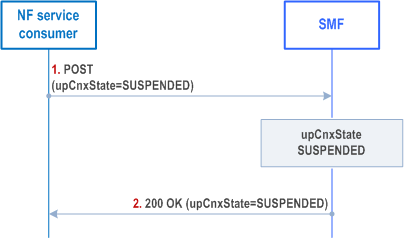
Step 1.
The NF Service Consumer shall request the SMF to suspend the user plane connection of the PDU session by sending a POST request, as specified in clause 5.2.2.3.1, with the following information:
Step 2.
- upCnxState attribute set to SUSPENDED;
- user location and user location timestamp;
- N2 SM information received from the 5G-AN, including UE Context Suspend Request Transfer IE, if available;
- other information, if necessary.
Upon receipt of such a request, the SMF shall deactivate the N3 tunnel of the PDU session, set the upCnxState attribute to SUSPENDED and return a 200 OK response including the upCnxState attribute set to SUSPENDED. The SMF shall store the N3 tunnel info (including both AN Tunnel Info and the CN Tunnel Info), and upon receiving subsequent DL Data report from the UPF, the SMF will invoke the Namf_MT EnableUEReachability service operation to trigger the AMF to page the UE.
5.2.2.3.16 Connection Resume in CM-IDLE with Suspend procedure |R16| p. 49
The NF Service Consumer (e.g. AMF) shall request the SMF to resume the User Plane connection of an existing PDU session, i.e. establish the N3 tunnel between the 5G-AN and UPF, as follows.
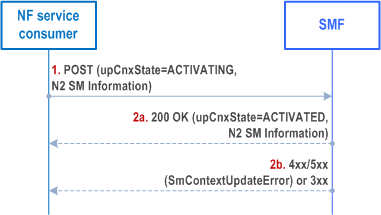
Step 1.
The NF Service Consumer shall request the SMF to resume the user plane connection of the PDU session by sending a POST request, as specified in clause 5.2.2.3.1, with the following information:
Step 2a.
- the upCnxState attribute set to ACTIVATING;
- user location and user location timestamp;
- cause attribute set to "PDU_SESSION_RESUMED";
- N2 SM information received from the 5G-AN, i.e. Path Switch Request Transfer including the new transport layer address and tunnel endpoint of the downlink termination point for the user data for this PDU session (i.e. 5G-AN's GTP-U F-TEID for downlink traffic), or UE Context Resume Request Transfer;
- additional N2 SM information received from the 5G-AN, if any;
- the "MO Exception Data Counter" if the UE has accessed the network by using "MO exception data" RRC establishment cause;
- other information, if necessary.
If the SMF can proceed with resuming the user plane connection of the PDU session, the SMF shall return a 200 OK response including the following information:
Step 2b.
- the upCnxState attribute set to ACTIVATED;
- N2 SM information, i.e. Path Switch Response Transfer including the transport layer address and tunnel endpoint of the uplink termination point for the user data for this PDU session (i.e. UPF's GTP-U F-TEID for uplink traffic), or UE Context Resume Response Transfer.
If the SMF cannot proceed with resuming the user plane connection of the PDU session, the SMF shall return an error response, as specified for step 2b of Figure 5.2.2.3.1-1, including:
- the upCnxState attribute representing the final state of the user plane connection (e.g. SUSPENDED);
- N2 SM information, including the cause of the failure.